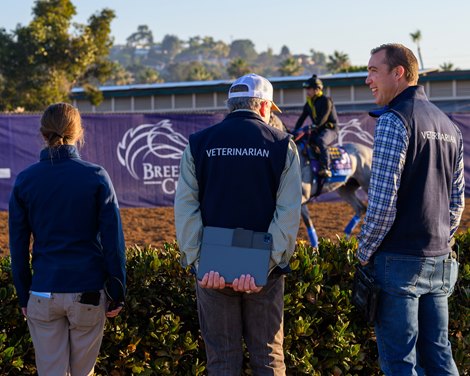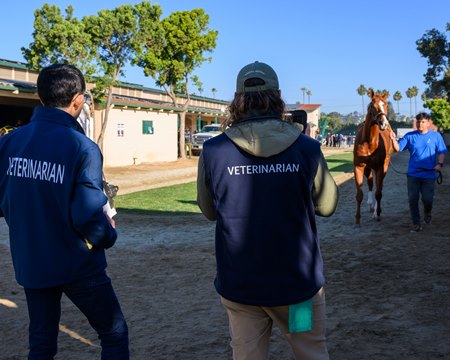As Breeders' Cup tries to support industry efforts to gather more information on exercise-associated sudden deaths, all horses in this year's World Championships and undercard races will be auscultated—examined with a stethoscope or electrocardiogram—in their stalls at rest.
Dr. Will Farmer, Breeders' Cup's co-veterinary lead, said this will be the first time such monitoring has been conducted. He said it will provide a baseline as Breeders' Cup develops a risk assessment protocol in this area.
"While we continue to make headway in identifying and preventing lower limb injuries, as an industry we're simultaneously working to understand the factors associated with equine exercise-associated sudden death, also known as EASD," Farmer said. "While EASD events are more rare than catastrophic musculoskeletal injuries, the danger they pose to other horses and riders is recognized.
"In an effort to help in the exploration into why these events happen, the Breeders' Cup veterinary team will be auscultating all horses entered on both Friday and Saturday's cards. As many of you may know, HISA has been spearheading an EASD project, and our goal is to be able to help support their work."
Farmer said vets will use a combination of standard auscultation along with portable ECG readings to complete these evaluations. With the Horseracing Integrity and Safety Authority's support, any cardiac rhythm abnormality will be reviewed by equine cardiac specialists, along with the horse's attending veterinarian.
At last year's Breeders' Cup, French-bred Jayarebe died from an EASD event after finishing seventh in the Breeders' Cup Turf (G1T).
Equine deaths in racing and training are rare, with HISA reporting that for its tracks from July 1, 2024-June 30, 2025, the nationwide racing-related fatality rate was 1.02 per 1,000 starts. That is to say horses avoided such incidents 99.9% of the time.
EASD incidents such as Jayarebe's account for a small subset of those rare instances of equine deaths in racing or training, but it is the subset for which the least knowledge has been gathered. Knowing there is an information void regarding these types of equine fatalities, HISA sees potential for safety gains if more can be learned about these instances that in the first six months of 2025 accounted for approximately 8% of racing fatalities and 18% of training fatalities at racetracks and training centers under HISA oversight.
"We've been working collaboratively with the Breeders' Cup team and other veterinary teams across the country because EASD was, and still continues to be, as a black box," said HISA CEO Lisa Lazarus. "While we've made so much progress in the musculoskeletal area, with EASD we've just had no idea up until now. We really are in the same situation as every international jurisdiction.
"So HISA has been working with a number of teams in a global initiative. There have been a number of discoveries that we've made. We're very much at the beginning, but we're grateful to the Breeders' Cup for being open to incorporating some of that newly found information into the procedures today. I think over time, as we continue to progress, we'll be able to incorporate more and more each year."

New Technology Tool
As Breeders' Cup, HISA, and many others aim to make racing safer, they're welcoming new technology. Farmer said Oct. 29 that the 21 or more regulatory veterinarians gathered at this year's Breeders' Cup will use the Sleip app for the first time.
The app uses artificial intelligence technology to track more than 100 anatomical key points on the moving horse, quantifying gait asymmetry and detecting even small irregularities. Such technology could pick up an issue with a horse before the human eye recognizes it.
"Over the last few years, Sleip has been used both by trainers and veterinarians alike in an effort to catalog an individual horse's gait over time, as well as provide an assessment of how that horse moves at that moment," Farmer said. "Sleip has been utilized by both domestic and international regulatory agencies as a tool for regulatory veterinarians to document horses' unique gates, including Britain, Hong Kong, Dubai, Saudi Arabia, and Australia. All of our team has access to Sleip and as well as previous videos, if they are available, on specific participants for their analysis."
Farmer noted that such analysis will provide a tool in evaluating horses but will not be the determining factor on if a horse is approved to run. Regulatory vets will use all available information in making those decisions.









